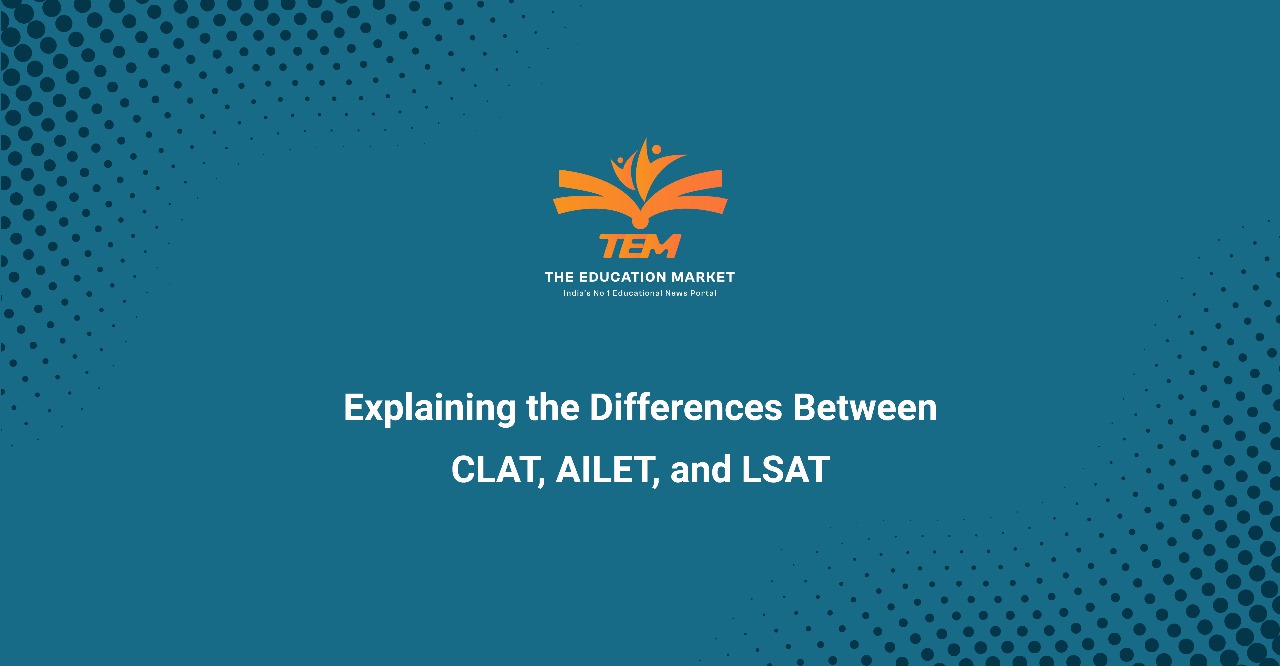Students in India who plan to pursue law as their career must be informed about different examinations that are taken for admission into the respective law courses. CLAT is one of the most significant exams, along with AILET, and LSAT. Structurally, academically, functionally, and regarding the target institutions, no two tests are similar. Therefore, this article aims to highlight the differences among these examinations so law aspirants can avoid confusion and prepare effectively.
Common Law Admission Test (CLAT):
Overview
The Consortium of National Law Universities, comprised of representative universities, conducts the Common Law Admission Test (CLAT) as a national-level centralized entrance exam. This exam grants admission into UG (Undergraduate) and PG (Postgraduate) law programs across various NLUs in India.
Structure
The UG CLAT exam consists of five sections. They are:
- English Language: This section includes questions on comprehension and grammar.
- Current Affairs, including General Knowledge: Questions are scenario-specific, pertain to the latest happenings around the world, or contain information expected to be in the public domain.
- Legal Reasoning: This area evaluates the candidate’s knowledge of the laws and how they will apply or be applied in a given situation.
- Logical Reasoning: It entails questions on logical and analytical thinking.
- Quantitative Techniques: In this section, questions are asked from arithmetic operations up to the 10th standard.
While the PG CLAT consists of areas such as Constitutional Law, Jurisprudence, and other law-related topics.
Marking Scheme
Every correct are earns one mark while every wrong answer reduces the overall mark by 0. 25 marks.
Institutions
The scores of CLAT are considered by 22 NLUs and many private law institutes in entire India.
Also Read: 7 Best CLAT Coaching Institutes in Delhi
All India Law Entrance Test (AILET)
Overview
The National Law University, Delhi (NLU Delhi) solely organizes the All India Law Entrance Test (AILET). Unlike the CLAT, which multiple universities accept, AILET grants admission only to NLU Delhi.
Structure
The UG AILET exam comprises the following sections. They are:
1. English: This is similar to CLAT where the candidate’s comprehension, vocabulary, and grammar are assessed.
2. General Knowledge and Current Affairs: It is a result of annual and/or monthly changes in knowledge and static knowledge about general facts.
3. Legal Aptitude: Questions test content knowledge concerning legal matters and critical thinking skills.
4. Reasoning: Embraces and entails problem-solving as well as critical thinking.
5. Mathematics: It is a test of numerical skill at a simple level.
In the PG AILET, the test comprises 100 MCQs and there is one law-based essay question.
Marking Scheme
Every correct response on the UG exam earns a mark; there is no penalty for an incorrect response in the exam. The PG exam also does not include any system of negative marking.
Institutions
Only NLU Delhi admits students based on the AILET scores.
Also Read: 7 Best CLAT Coaching Institutes in Gurgaon
The Law School Admission Test or commonly known as LSAT.
Overview
The Law School Admission Council (LSAC) administers the LSAT, a globally recognized aptitude test for prospective law students. However, it’s important to distinguish between the LSAT and LSAT-India. LSAT-India is a separate test developed specifically for Indian law schools by LSAC.
Structure
LSAT—India consists of four sections. They are:
1. Analytical Reasoning: It focuses on the core skills that involve assessing a structure of relationships and deriving conclusions that logically follow.
2. Logical Reasoning (1 and 2): Specifically measures reasoning and the capability of identifying and assessing various forms of reasoning and arguments.
3. Reading Comprehension: Assesses ability in reading and comprehending texts.
LSAT—India does not have a section specifically dedicated to mathematics.
Marking Scheme
LSAT—India comes in the form of scores and not the raw marks that a candidate might be used to. It ranges between 420 to 480.
Institutions
Numerous law colleges in India, such as Jindal Global Law School and IIT Kharagpur’s Rajiv Gandhi School of Intellectual Property Law, recognize LSAT-India scores.
Also Read: 7 Best CLAT Coaching Institutes in India
Key Differences
Purpose and Scope
CLAT: Mainly for admission to NLUs as well as other law colleges associated with it in the Indian territory.
AILET: This is only applicable in NLU Delhi.
LSAT—India: For diverse private law schools of India which has international exposure.
Structure and Content
CLAT: It emphasizes on English, Current Affairs, Legal Reasoning, Logical Reasoning, and Quantitative Techniques.
AILET: It is also like CLAT but the emphasis is slightly different and there is no provision for negative marking in this exam.
LSAT—India: Available and formed as Analytical Reasoning, Logical Reasoning, and Reading Comprehension only and does not include a mathematical section.
Marking Scheme
CLAT: The negative marking for all the wrong answers is 0.25.
AILET: There is no aspect of negative marking in this exam.
LSAT—India: Uses a scaled scoring system.
Acceptance
CLAT: Accepted by 22 NLUs and several other institutes.
AILET: Accepted only by NLU Delhi.
LSAT—India: Recognised by numerous self-financed law schools in India.
Also Read: Best Books for CLAT Preparation
Preparation Tips
CLAT
1. Understand the Syllabus: Get to know each section and understand what is expected of you.
2. Regular Practice: Solve past papers and give mock examinations.
AILET
1. Mock Tests: Regular mock exams can help in understanding and time management.
2. No Negative Marking: As there is no deduction for the wrong answers, therefore it is advisable to attempt all the questions.
LSAT—India
1. Develop Analytical Skills: Practice analytical and logical reasoning questions regularly.
2. Practice Tests: Prepare and solve LSAT-specific practice tests to get used to the format of the exam.
Also Read: How To Prepare For CLAT Exam?
Conclusion
The most important decision that a student planning to pursue law in India has to make is the selection of the law entrance examination. CLAT opens the door to several NLUs, AILET is specifically for NLU Delhi, and LSAT—India offers hopes for various private colleges for law. Understanding the difference between the structure, content, and acceptance of these examinations can help the students to prepare accordingly.
Related Article: Best YouTube channels for CLAT preparation
Syllabus of CLAT Entrance Examination
Is Coaching Necessary to Crack CLAT Exam?

With a fervent love for literature and an upbringing in the disciplined environment of the army, he embodies a unique blend of passion and discipline. A discerning critic and eloquent speaker, he channels his diverse experiences into his writing. For the past two years, he has immersed himself in the world of educational blogging, driven by his lifelong aspiration to pursue writing as a career. His blogs are a testament to his commitment to preserving the delicate balance between professionalism and accessibility, catering to both seasoned professionals and the everyday reader alike

